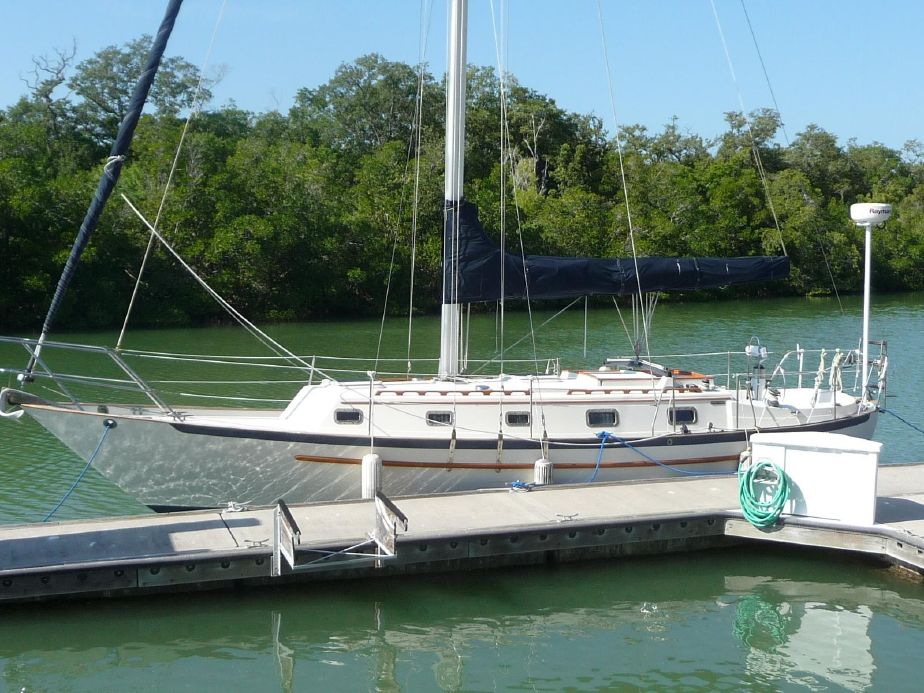If I have learned anything in my years in the recreational boating business, it’s to refrain from imposing personal preferences for aesthetics on others, particularly clients. What’s significantly more important is how well any particular boat or design feature is suited for its intended use. Over the years, the Pacific Seacraft 37 has gained a reputation as one of the best and most versatile designs the cruising sailboat market has to offer. So, with those first thoughts in mind, I will try to overlook my personal opinion of this design. Instead, I’ll concentrate on those features that make the design well-suited or not so well-suited for the serious cruising sailor.
The Pacific Seacraft 37 was designed by W.I.B. Crealock, first built in 1978 by Cruising Consultants Inc. of Newport Beach, CA, and marketed as the Crealock 37. In 1980, Pacific Seacraft Corp. of Fullerton, CA, a company that was already making a name for itself specializing in small, high-quality, cruising sailboats, acquired the tooling. Over the last 20 years the Pacific Seacraft/Crealock 37 has, in some minds, set the standard for bluewater cruisers in this size range.
For the most part, I would classify Pacific Seacraft as a conservative boat builder using proven fiberglass construction techniques. This does not necessarily mean old-fashioned. The hull is an uncored solid laminate of fiberglass and resin. Pacific Seacraft did offer balsa wood or foam core for those who wanted added insulation and were willing to pay the cost.
A full-length molded fiberglass hull liner is used to provide a significant part of the structural integrity. The liner contains built-in components for tanks, furniture, floors, and engine beds as well as recesses for bulkheads. Unlike poorly designed hull liners, Pacific Seacraft’s liner provides numerous openings so that it may be securely attached and inspected.
Critical components, such as the structural bulkhead at the forward end of the main cabin, are both fiberglassed and bolted for extra strength. The decks utilize plywood rather than balsa wood core, and the deck and hull are securely bolted together with an adhesive sealant. In short, there are few production boats that are as solidly constructed as the Pacific Seacraft 37.
Of course, nothing is perfect and there are two flaws that I frequently run across. First, I have seen several early-to-mid 1980s boats that have developed a significant number of osmotic blisters. The cases I’ve seen don’t seem to be a concern structurally but are a cosmetic eyesore and, if left unattended, will only worsen. The second problem arises from Pacific Seacraft’s practice of locating aluminum fuel tanks in the bilge space. It’s tough to beat using this otherwise wasted space for tankage, but exposures to bilge water can rapidly corrode aluminum tanks and I prefer to see fiberglass tanks used in bilges.
Over the years, the 37s have been powered with several auxiliary engines ranging from a 24-Hp Volvo to the current 50-Hp Yanmar. All seem to be adequate with the 50-Hp Yanmar being a bit of overkill, in my opinion.
Compared to most modern production 37’ cruisers, the interior of the Pacific Seacraft 37 is not particularly spacious. However, it is an excellent compromise between livability at anchor or dockside and seagoing comfort essential for a true bluewater cruiser. The forward cabin offers privacy and a 50" wide double berth suitable for two average sized adults. The head is well-ventilated and offers excellent storage space. There are two good sea berths in the main saloon with leecloths as standard equipment.
There is 6’ 4" of headroom and plenty of well-positioned grab rails throughout. The port side quarter berth cabin, which is optimistically described in company literature as a double berth, is only 43" wide at maximum and about 30" wide minimum. This is much too small for a double but a very comfortable single berth. The galley is a little short on counter space, and seawater sloshes around in the bottom of the deep sink under sail; otherwise, it is very well laid out and functional.
Some of the best topside features are the secure feeling offered by a raised bulwark surrounding the deck, 30" high double life lines, and foredeck cleats actually substantial enough to secure a storm anchor. One weakness is the cramped space beneath the cockpit dodger that makes it difficult to crank winches and handle lines that are led aft to the cockpit.
The Pacific Seacraft 37 has been rigged as a sloop, cutter or yawl. There is little justification for the yawl rig and the added mast and standing rigging only clutters up the cockpit. The cutter seems to have been the rig of choice for most buyers. It can be balanced well with reduced sail and is an excellent choice for offshore use. No matter what rig, the performance of the Pacific Seacraft 37 surprises most the first time they have a chance to sail her. She is very agile, tacks through about 85 degrees or perhaps a little better if the water is not sloppy, and tracks very well. Boat speed is very respectable under all but very light air conditions. She is one of the few true bluewater cruisers that I would consider for primary use on the Chesapeake Bay.
Lastly, if you’ll permit me one little personal opinion. I think the Pacific Seacraft/Crealock 37 is one of the most handsome yachts afloat and one I think most sailors would be proud to own.
Reviewed in the November 2002 issue of SpinSheet by Jack Hornor





